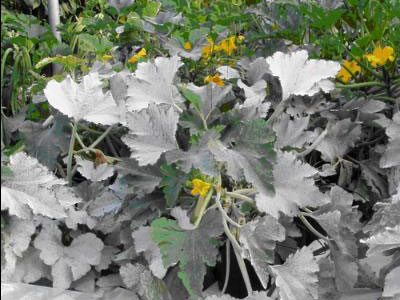Powdery Mildew

Severe powdery mildew infestation on greenhouse-grown squash (Cucurbita spp.). ©UF/IFAS.
Powdery mildew is a serious fungal disease that attacks a wide range of plants, from squash to roses. Crapemyrtles are especially susceptible. The symptoms are unmistakable: spots or patches of white powder, usually on the leaves.
These spots quickly enlarge, turning into a dusty white or gray coating. The symptoms usually appear late in the growing season.
Like all fungi, powdery mildew favors moist conditions and will thrive in humid weather, crowded plantings, and shade.
Damage to infected plants can include the stunting of leaves, buds, and fruit. Leaves may yellow and drop and the plant will suffer as it loses nutrients to the fungus.
To treat powdery mildew, spray infected plants with a fungicide labeled specifically for this disease. As always, follow all label instructions.
Powdery mildew on crapemyrtle is caused by the fungus Erysiphe lagerstroemiae. It causes leaves, stems, and flowers to become distorted and stunted. In severe cases, leaves may drop prematurely and flower buds may fail to open properly. Shady, humid locations and cool nights encourage powdery mildew, as does frequent wetting of the foliage by irrigation or rainfall. But there are now varieties of resistant crapemyrtles available.
Powdery mildew is more prevalent in spring and fall. The best way to avoid this problem is to plant one of the crapemyrtle cultivars bred and selected for resistance to powdery mildew. It also help to plant your crapemyrtle in sunny locations, allowing free air movement so that wet foliage dries quickly.
UF/IFAS Publications
- Management of Powdery Mildew in Beans
- Powdery Mildew of Tomato
- Powdery Mildew on Nasturtium in South Florida

